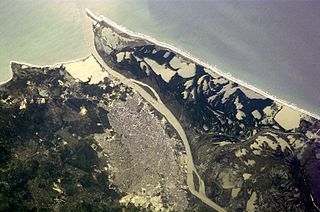
Buenos Aires, officially the Buenos Aires Province, is the largest and most populous Argentine province. It takes its name from the city of Buenos Aires, the capital of the country, which used to be part of the province and the province's capital until it was federalized in 1880. Since then, in spite of bearing the same name, the province does not include Buenos Aires city, though it does include all other parts of the Greater Buenos Aires metropolitan area. The capital of the province is the city of La Plata, founded in 1882.

Bahía Blanca is a city by the Atlantic Ocean, in the southwest province of Buenos Aires, Argentina. It is the seat of government of the Bahía Blanca Partido, with 301,572 inhabitants according to the 2010 census [INDEC]. Bahía Blanca is the principal city in the Greater Bahía Blanca area.

The history of immigration to Argentina can be divided into several major stages:
Irish Argentines are Argentine citizens who are fully or partially of Irish descent. Irish emigrants from the Midlands, Wexford and many counties of Ireland arrived in Argentina mainly from 1830 to 1930, with the largest wave taking place in 1850–1870. The modern Irish-Argentine community is composed of some of their descendants, and the total number is estimated at between 500,000 and 1,000,000.

Argentina has a racially and ethnically diverse population. The territory of what today is Argentina was first inhabited by numerous indigenous peoples. The first white settlers came during the period of Spanish colonization, beginning in the 16th century. The Spaniards imported African slaves, who would go on to become the first Afro-Argentines. Following independence from Spain in the 19th century and well into the 20th century, numerous migration waves took place, with Argentina being the second most popular destination for migrants in the early 20th century, after the United States. Most of these migrants came from Europe.

Colombians are people identified with the country of Colombia. This connection may be residential, legal, historical or cultural. For most Colombians, several of these connections exist and are collectively the source of their being Colombian.
Coronel Pringles is a city in the south of the Buenos Aires Province in Argentina, situated near the mountains of Pillahuincó. It is the government seat of the Coronel Pringles Partido.

Ernesto Carlos Tornquist was an Argentine entrepreneur and businessman, considered to be one of the most important entrepreneurs in Argentina at the end of the 19th century.

Immigration to Colombia during the early 19th and late 20th Century, is what makes it one of the most diverse countries in the world, above other countries in the Latin region. Colombia inherited from the Spanish Empire harsh rules against immigration, first in the Viceroyalty of New Granada and later in the Colombian Republic. The Constituent Assembly of Colombia and the subsequent reforms to the national constitution were much more open to the immigrants and the economic aperture. However naturalization of foreigners, with the exception of those children of Colombians born abroad, it is still difficult to acquire due 'Jus soli' law is not allowed by the government, and only 'Jus sanguinis' law is accepted. Immigration in Colombia is managed by the "Migración Colombia" agency.

Cape Verdean Argentines are Argentine residents whose ancestry originated in Cape Verde. According to the 1980 census, there were about 8,000; but today's population was estimated by some sources to be around 2,000 in 2007. Other sources estimate that in 2023 there were 30,000 descendants of immigrants from Cape Verde living in Argentina, of whom about 300 are native to the African continent.

Argentines are the people identified with the country of Argentina. This connection may be residential, legal, historical or cultural. For most Argentines, several of these connections exist and are collectively the source of their being Argentine. In the past the National Gentilic for Citizens of Argentina was mistakenly translated as Argentinians, a term that is no longer considered accurate.

European Argentines, are Argentines who have predominantly or total European ancestry, belong to several communities which trace their origins to various migrations from Europe and which have contributed to the country's cultural and demographic variety. They are the descendants of colonists from Spain during the colonial period prior to 1810, or in the majority of cases, of Spanish, Italians, French, Russians and other Europeans who arrived in the great immigration wave from the mid 19th to the mid 20th centuries, and who largely intermarried among their many nationalities during and after this wave. No recent Argentine census has included comprehensive questions on ethnicity, although numerous studies have determined that European Argentines have been a majority in the country since 1914.

Ricardo Daniel Eliçabe EchaveFRPSL was an Argentine physician who had a career in the petroleum industry. In 1925, he co-founded the Refinería de Petróleo "La Isaura" S.A. in Bahía Blanca, a company of which he was later president. The Dr. Ricardo Eliçabe Refinery in Bahía Blanca is named for him.
Argentine immigration to France refers to Argentine citizens living in the European country.
At the 2011 census, the number of immigrants in Costa Rica totaled about 390,000 individuals, or about 9% of the country's population. Following a considerable drop from 1950 through 1980, immigration to Costa Rica has increased in recent decades.

Bahía Blanca Sud is a railway station of the Argentine rail network, part of the General Roca Railway. Originally built and operated by the Buenos Aires Great Southern Railway, it is located in the city of Bahía Blanca, Buenos Aires Province. In November 2014 the station was declared National Historical Monument by the Argentine government.

Diplomatic relations between the Argentine Republic and the Bolivarian Republic of Venezuela have existed for decades.

Venezuelan Argentines are Argentine citizens of predominantly or total Venezuelan descent, or Venezuelan citizens who have migrated to and settled in Argentina. As of 2022, there are 272,000 Venezuelans living in Argentina, most of whom migrated during the latter half of the 2010s as part of the Venezuelan refugee crisis. The last census held in Argentina, in 2010, registered only 6,000 Venezuelan migrants living in the country.

The National Directorate for Migration is a decentralised agency of the Government of Argentina responding to the Secretariat of the Interior which is responsible for handling the country's migration policies.

Peruvian Argentines are Argentine citizens of partial or full peruvians descent, or Peruvian citizens who have migrated to and settled in Argentina.

















